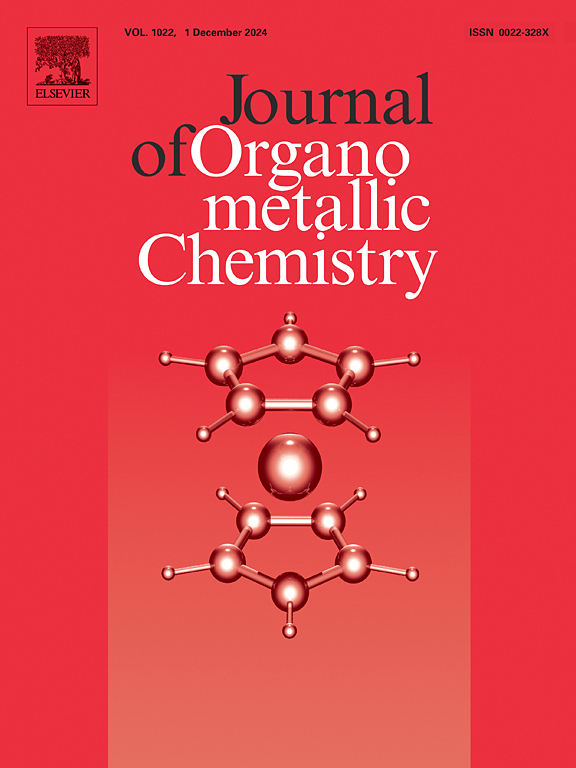Biological and computational studies of organometallic compounds of rhenium(I) with substituted phenyl(2-(thiazol-4-yl)-1H-benzo[d]imidazol-1-yl)methanone
IF 2.1
3区 化学
Q3 CHEMISTRY, INORGANIC & NUCLEAR
引用次数: 0
Abstract
The organometallic compounds of Re(I) with substituted phenyl(2-(thiazol-4-yl)-1H-benzo[d]imidazol-1-yl)methanone were synthesized and characterized utilizing a variety of spectroscopic techniques. Viscosity and absorption titration measurements evaluated the CT-DNA binding capabilities with synthesized compounds. The finding points to an intercalation form of binding, corroborated by additional molecular docking research. A study on BSA binding was conducted to ascertain the strength of the synthetic compounds' binding to proteins. The synthesized compounds were tested against three Gram-negative strains and two Gram-positive strains, their antibacterial activities were greater than that of the ligands alone. An ADME study using Swiss ADME techniques shed light on the compounds' pharmacokinetic characteristics. Using density functional theory (DFT), the molecular orbital energies of the synthesized compounds were calculated. The compound's cytotoxicity was evaluated using a bioassay for brine shrimp mortality. Additionally, the produced compounds were examined for their anticancer properties using the cell line of the MCF-7. Surprisingly, the obtained IC50 values showed a similar antiproliferative effect to those of conventional drugs.
铼(I)与取代苯(2-(噻唑-4-基)- 1h -苯并[d]咪唑-1-基)甲烷的有机金属化合物的生物学和计算研究
合成了Re(I)与取代苯基(2-(噻唑-4-基)- 1h -苯并[d]咪唑-1-基)甲烷酮的有机金属化合物,并利用各种光谱技术对其进行了表征。粘度和吸收滴定测量评估了CT-DNA与合成化合物的结合能力。这一发现指出了一种嵌入形式的结合,并得到了额外的分子对接研究的证实。通过对牛血清白蛋白结合的研究,确定了合成的化合物与蛋白质结合的强度。合成的化合物对3株革兰氏阴性菌和2株革兰氏阳性菌的抑菌活性均优于单独的配体。一项使用瑞士ADME技术的ADME研究揭示了化合物的药代动力学特征。利用密度泛函理论(DFT)计算了合成化合物的分子轨道能。该化合物的细胞毒性用盐水虾死亡率生物测定法进行了评估。此外,使用MCF-7细胞系检测了所产生的化合物的抗癌特性。令人惊讶的是,获得的IC50值显示出与传统药物相似的抗增殖作用。
本文章由计算机程序翻译,如有差异,请以英文原文为准。
求助全文
约1分钟内获得全文
求助全文
来源期刊

Journal of Organometallic Chemistry
化学-无机化学与核化学
CiteScore
4.40
自引率
8.70%
发文量
221
审稿时长
36 days
期刊介绍:
The Journal of Organometallic Chemistry targets original papers dealing with theoretical aspects, structural chemistry, synthesis, physical and chemical properties (including reaction mechanisms), and practical applications of organometallic compounds.
Organometallic compounds are defined as compounds that contain metal - carbon bonds. The term metal includes all alkali and alkaline earth metals, all transition metals and the lanthanides and actinides in the Periodic Table. Metalloids including the elements in Group 13 and the heavier members of the Groups 14 - 16 are also included. The term chemistry includes syntheses, characterizations and reaction chemistry of all such compounds. Research reports based on use of organometallic complexes in bioorganometallic chemistry, medicine, material sciences, homogeneous catalysis and energy conversion are also welcome.
The scope of the journal has been enlarged to encompass important research on organometallic complexes in bioorganometallic chemistry and material sciences, and of heavier main group elements in organometallic chemistry. The journal also publishes review articles, short communications and notes.
 求助内容:
求助内容: 应助结果提醒方式:
应助结果提醒方式:


